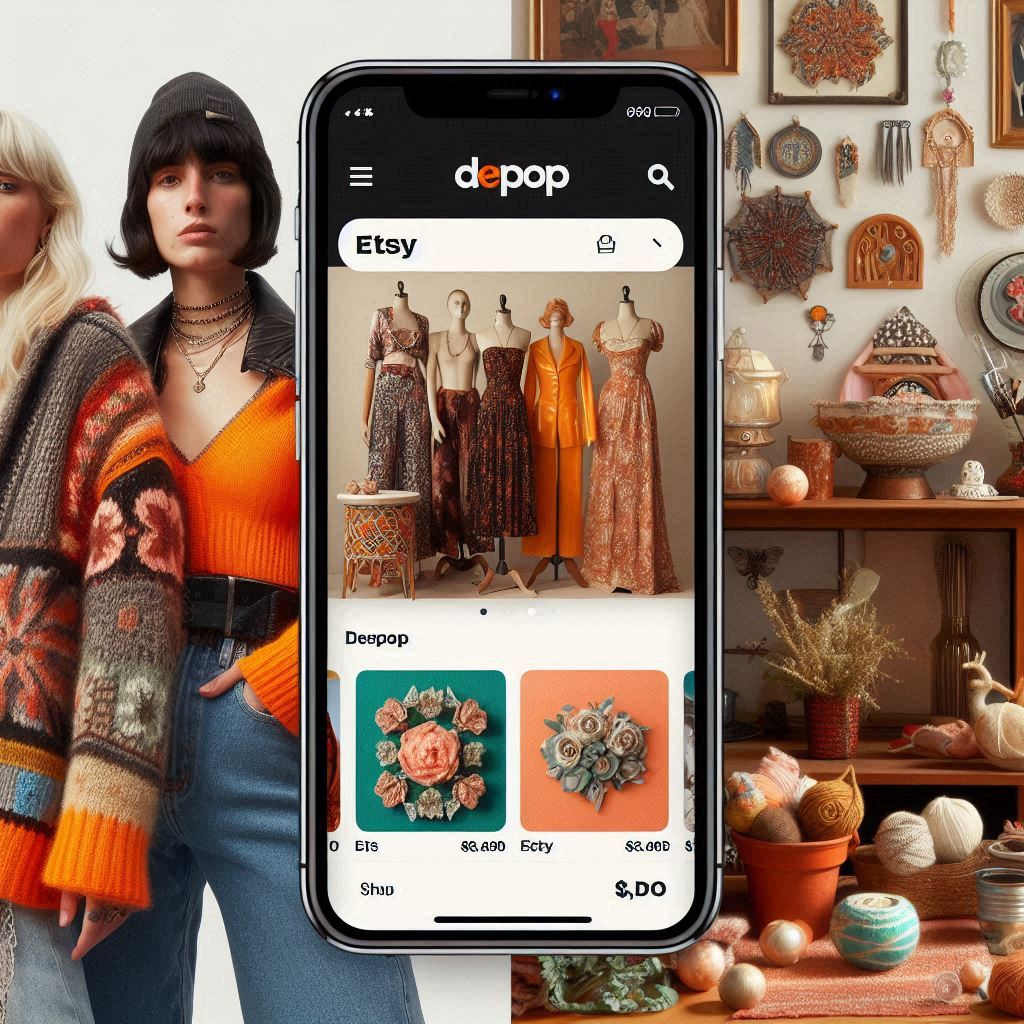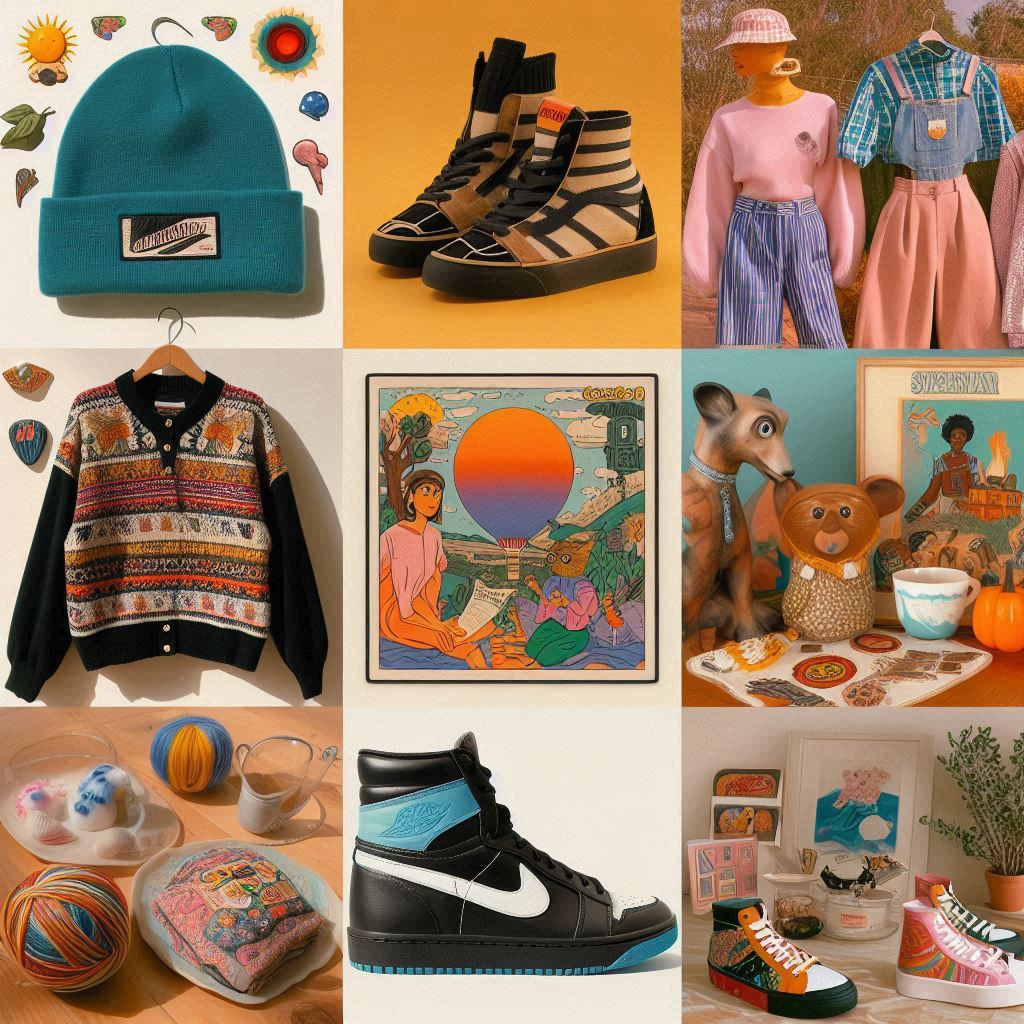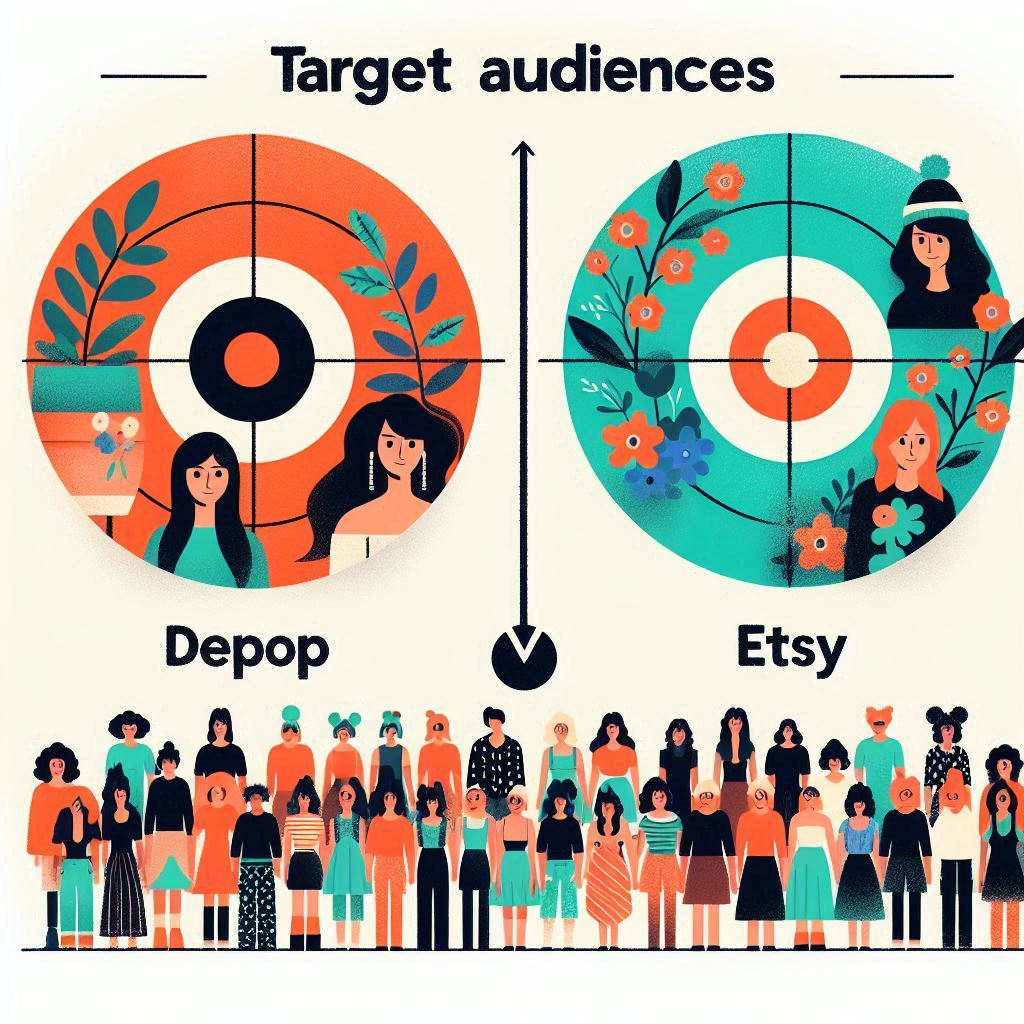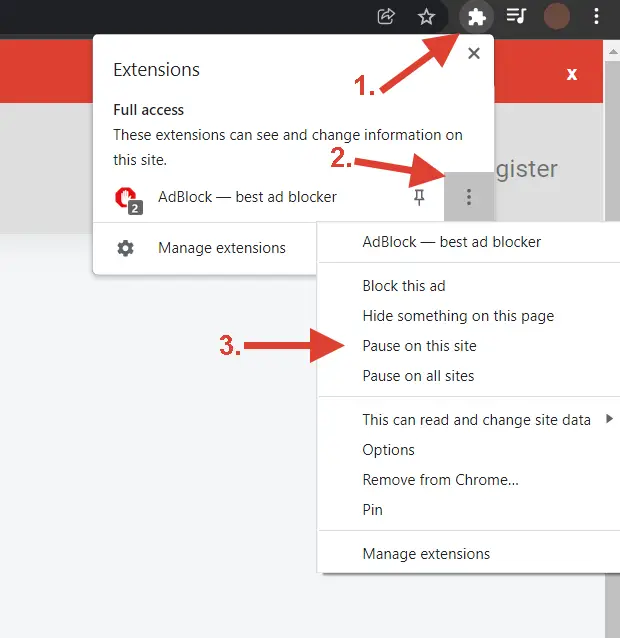Are you a creative entrepreneur ready to share your passion with the world? Choosing the right online marketplace is crucial for success, especially when it comes to selling handmade, vintage, or unique items. Two prominent contenders often top the list: Depop and Etsy. Both platforms offer a vibrant marketplace to connect with buyers, but they cater to different audiences and product categories.
This comprehensive guide delves deep into the Depop vs Etsy debate, providing a detailed comparison to help you determine the ideal platform to launch or expand your online selling journey.
I. Understanding the Key Differences: Depop vs. Etsy
While both Depop and Etsy operate as online marketplaces, they differ significantly in terms of their target audience, product focus, fee structure, and overall selling experience. Understanding these nuances is essential for choosing the platform that best aligns with your business goals.
Target Audience
Depop: Picture a bustling online community where fashion-forward Gen Z and millennials reign supreme. Depop thrives on its youthful and trendy vibe, attracting a digitally savvy demographic that embraces secondhand fashion as a means of self-expression and sustainability. With its visually engaging interface reminiscent of social media platforms like Instagram, Depop appeals to trend-conscious shoppers seeking unique and affordable pre-loved finds.
Etsy: Imagine a sprawling virtual craft fair where handmade goods, vintage treasures, and creative supplies converge. Etsy boasts a broader audience encompassing a wider age range, appealing to those who value craftsmanship, uniqueness, and supporting independent creators. While Etsy also attracts younger shoppers, its user base extends to those seeking a more traditional online shopping experience, often with a focus on gifting and home décor.

Product Focus
Depop: Depop specializes in secondhand fashion, with a particular emphasis on vintage clothing, streetwear, Y2K styles, and one-of-a-kind pieces. Think band tees, retro sneakers, designer handbags, and unique upcycled creations. If your passion lies in curating a stylish selection of pre-loved apparel and accessories, Depop is your haven.
Etsy: Etsy, on the other hand, embraces a much broader spectrum of products, spanning handcrafted goods, art, jewelry, home décor, vintage finds, and craft supplies. From personalized gifts to custom-made furniture, Etsy caters to a diverse range of interests. One of Etsy’s distinguishing features is its allowance for selling digital products like printable art, sewing patterns, and website templates, opening up additional income streams for creative entrepreneurs.

Fees and Pricing Structure
Both Depop and Etsy operate on a transaction fee model, meaning they take a percentage of each sale you make. However, their specific fees and pricing structures differ, impacting your overall profit margins.
Depop: Depop charges a 10% transaction fee on all sales, plus a payment processing fee, typically around 3%.
Etsy: Etsy charges a 6.5% transaction fee on each sale, which includes payment processing. Additionally, there’s a $0.20 listing fee for every item you list in your shop.
Understanding these fee structures is crucial when determining your pricing strategy. Depop, with its potentially higher profit margins due to a lower transaction fee, may be more attractive for those selling lower-priced items. Etsy, while having slightly higher fees, offers a larger established marketplace, potentially justifying the added cost.
Shipping and Fulfillment
Depop: Depop sellers are responsible for handling their own shipping and fulfillment processes. This means you’ll need to package, label, and ship your items directly to buyers, managing all associated costs and logistics. While this offers greater control over shipping choices, it also requires more time and effort.
Etsy: Similar to Depop, Etsy sellers manage their own shipping arrangements. However, Etsy offers the option to use Etsy shipping labels, providing discounted rates and streamlining the label printing process. While Etsy doesn’t offer integrated fulfillment services like Amazon FBA, their shipping label option provides some level of convenience for sellers.

Branding and Shop Customization
Building a strong brand identity is essential for standing out in a crowded marketplace. Depop and Etsy offer different approaches to branding and shop customization, impacting how you present your products and connect with your target audience.
Depop: Depop leverages a social media-like approach to shop profiles, allowing sellers to curate an aesthetic feed that reflects their personal style and brand vibe. High-quality product photography, consistent branding elements, and engaging captions are key for attracting attention and building a loyal following.
Etsy: Etsy provides more traditional shop customization options. Sellers can personalize their storefronts with custom banners, logos, and detailed shop descriptions to create a distinct brand experience. Etsy also offers tools for organizing product listings into categories, making it easier for buyers to navigate your shop and find what they’re looking for.

II. Pros and Cons: A Side-by-Side Comparison
To further clarify the nuances of Depop vs Etsy, let’s delve into a direct comparison of their pros and cons, weighing the advantages and disadvantages of each platform:
| Feature | Depop | Etsy |
| Target Audience | Gen Z and millennials focused on secondhand and vintage clothing | Broader audience, all ages, seeking handmade, vintage, and craft items |
| Product Focus | Pre-loved fashion, streetwear, vintage, Y2K | Wider range, including handmade crafts, art, jewelry, home decor, digital products |
| Fees | 10% transaction fee + payment processing fees | 6.5% transaction fee (including payment processing) + $0.20 listing fee |
| Shipping | Seller managed, no integrated services | Seller managed, with optional Etsy shipping labels |
| Branding | Social media-like profiles, emphasis on aesthetic | Customizable storefronts, brand building opportunities |
| Pros | Mobile-first, trendy, strong Gen Z community, potentially higher profit margins, fosters individual style, simple fee structure | Established marketplace, large audience, diverse product offerings, buyer protection, seller tools, built-in messaging, returns policy |
| Cons | Smaller overall audience, limited product categories, no returns policy, requires constant engagement, can be harder to stand out | More competition, lower profit margins (potentially), fees can add up, less emphasis on individual style, more complex fee structure |
III. Choosing the Right Platform: Factors to Consider
Navigating the Depop vs Etsy landscape ultimately comes down to aligning the platform’s strengths with your unique business needs and aspirations. Here are key factors to consider when making your decision:
- Your Target Market: Who are you trying to reach with your products? If your ideal customers are young, trend-conscious shoppers seeking secondhand fashion, Depop is a natural fit. However, if you’re targeting a wider audience with diverse interests, Etsy’s broad reach might be more beneficial.

- Product Type: What are you selling? Depop’s focus on pre-loved clothing limits your options to fashion-related items. Etsy, on the other hand, accommodates a vast range of products, giving you greater flexibility. If your inventory expands beyond clothing and accessories, Etsy might be the more versatile choice.
- Pricing Strategy: Carefully analyze the fee structure of each platform and its impact on your profit margins. Consider the average price point of your products and determine which platform allows for a comfortable profit margin after deducting fees. Depop’s lower transaction fee can be advantageous for lower-priced items, while Etsy’s larger audience and established reputation might justify its higher fees for higher-priced goods.
- Time Commitment: Building a successful online shop requires time and effort. Are you willing to invest the energy needed to create a visually appealing shop, optimize your listings for search, engage with your audience, and manage shipping and fulfillment? Depop, with its emphasis on frequent posting and social media-like engagement, demands more consistent attention. Etsy, while requiring similar effort in shop setup and optimization, might offer a slightly more relaxed pace.
- Long-Term Goals: What are your aspirations for your online shop? Do you envision a small-scale side hustle to supplement your income, or are you aiming for a full-fledged business with significant growth potential? Etsy, with its established marketplace and robust seller tools, might be better suited for building a larger, long-term business. Depop, while offering opportunities for growth, might be a good starting point for testing the waters or building a niche audience before potentially expanding to other platforms.
IV. Depop vs Etsy: FAQs
This section addresses some common questions that might arise when choosing between Depop and Etsy:
Which platform is better for beginners?
Both Depop and Etsy have their pros and cons for new sellers.
Depop: Depop’s mobile-first approach and intuitive interface make it relatively easy to get started. Listing items is straightforward, and the social media-like functionality feels familiar to many young entrepreneurs. However, standing out in Depop’s crowded marketplace requires a strong visual aesthetic and consistent engagement, which can be challenging for beginners.
Etsy: Etsy’s established marketplace offers a large potential audience, and its seller resources provide guidance on shop setup, product photography, and marketing strategies. The buyer protection program also provides a level of security for both sellers and buyers. However, Etsy’s fees and competition can be daunting for new sellers struggling to gain visibility.
Ultimately, the best platform for beginners depends on individual preferences and comfort levels with technology and marketing strategies. Experimenting with both platforms and exploring their free resources can be helpful in determining the best fit.
Which platform is better for making a profit?
The profit potential on both Depop and Etsy depends on several factors:
- Pricing Strategy: Depop’s lower transaction fees can translate into higher profit margins, especially for lower-priced items. However, competitive pricing is essential for attracting buyers, especially in a crowded marketplace.
- Product Uniqueness: Offering unique, desirable items, whether vintage finds, handmade creations, or specialized craft supplies, increases your chances of commanding higher prices and attracting loyal customers.
- Marketing and Branding: Effectively showcasing your products through high-quality photography, engaging descriptions, and strategic use of keywords and hashtags is essential for gaining visibility and driving sales on both platforms. Building a strong brand presence and engaging with your audience can also contribute to profit potential.
- Cost Management: Beyond platform fees, consider the cost of sourcing inventory, packaging materials, shipping, and any additional marketing expenses. Efficiently managing these costs contributes to overall profitability.
It’s challenging to definitively declare one platform superior for profit. Success on both Depop and Etsy requires a savvy combination of pricing strategy, product selection, marketing efforts, and cost management.
How do I get my items seen on Depop and Etsy?
Gaining visibility and attracting buyers is crucial for success on any online marketplace. Here are key strategies for both Depop and Etsy:
- SEO (Search Engine Optimization): Research relevant keywords and phrases that potential buyers might use to search for your products. Incorporate these keywords into your product titles, descriptions, and tags.
- High-Quality Photography: Visually appealing images are essential for capturing attention and showcasing your products in their best light. Use natural lighting, clean backgrounds, and multiple angles to highlight details and entice buyers.
- Engaging Descriptions: Craft compelling descriptions that highlight the unique features, benefits, and story behind your products. Use descriptive language, storytelling techniques, and relevant keywords to captivate readers and encourage purchases.
- Social Media Promotion: Leverage the power of social media platforms like Instagram, Pinterest, and TikTok to promote your shop, showcase your products, and engage with potential customers. Share high-quality images, behind-the-scenes glimpses, and exclusive offers to drive traffic to your Depop or Etsy shop.
- Depop Specific: On Depop, frequent posting is key for staying visible in the constantly refreshing feed. Regularly re-upload items, engage in conversations, and collaborate with other sellers to expand your reach.
What are the best-selling items on Depop and Etsy?
Understanding popular categories can provide insights into current trends and buyer demand.
Depop: Top-selling categories on Depop often reflect current fashion trends, including vintage sportswear, Y2K clothing, designer pieces, and unique upcycled creations.
Etsy: Etsy’s best-selling items span a wider range, encompassing personalized gifts, handmade jewelry, home décor, craft supplies, and digital downloads.

Researching trending categories within your chosen niche can help you identify in-demand products and refine your product offerings.
V. Conclusion
Choosing between Depop and Etsy is like selecting the perfect outfit – it depends on your individual style, target audience, and overall goals.
Depop: If you’re a fashion-forward entrepreneur with a passion for curating trendy secondhand finds, Depop offers a vibrant and visually driven platform to connect with a younger, trend-conscious demographic. Embrace its social media-like nature, engage actively with your audience, and showcase your unique style to thrive in this dynamic marketplace.
Etsy: If you’re a creative soul seeking a platform to showcase a diverse range of handmade, vintage, or craft items, Etsy’s established marketplace and extensive seller tools provide a solid foundation for building a successful online business. Leverage Etsy’s brand-building opportunities, utilize its diverse product categories, and tap into its larger audience to reach a wider range of buyers.
The beauty of these platforms lies in their accessibility. Don’t hesitate to experiment with both Depop and Etsy, explore their free resources, and determine which platform feels like the best fit for your creative vision and entrepreneurial aspirations.
Remember, success in the online marketplace requires dedication, creativity, and a deep understanding of your target market. By carefully considering the factors discussed in this guide, you’ll be well-equipped to make an informed decision and embark on a fulfilling journey as an online seller.
Try these free tools by Topbubbleindex
If you're looking to get started with print-on-demand, Topbubbleindex is the perfect place to begin. We offer all the digital marketing tools you need to be successful, and we're committed to keeping them free forever. Below, you'll find a few of the free tools we offer to help you get ahead of the competition and make sales easily.
- Redbubble Keyword Research
- Redbubble Tag Generator
- Redbubble Trends Finder
- Etsy Keyword Research
- Etsy Tag Generator
- Etsy Trends Finder
- Design Editor
- Image Background Remover
- Image Portrait Generator
- Blogs
- Calendar Holidays
And still counting! If you're still not impressed, try the Topbubbleindex tools for free. Don't hesitate to contact us for suggestions, complaints, or just feedback. We are always working on to keep the Topbubbleindex better.

